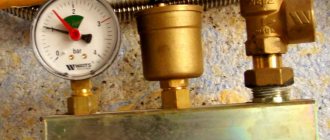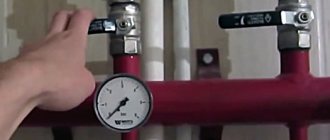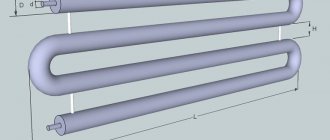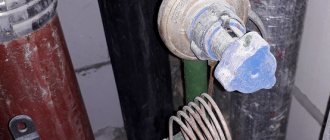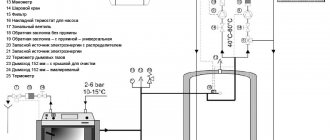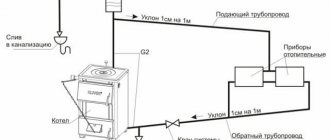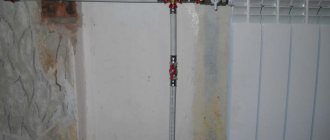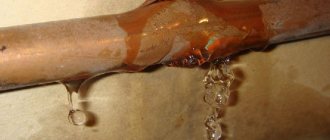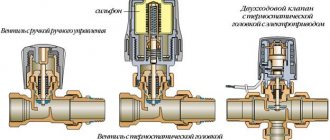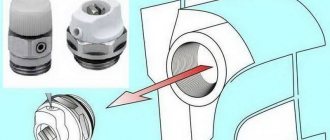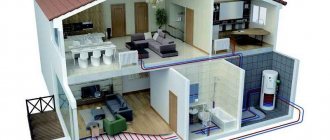Causes
Knowing what water hammer is in a water supply system, it is easy to identify the reasons for its occurrence. In this case, it is necessary to distinguish between negative and positive hydraulic shocks. The first occurs when water with high pressure enters a section of a pipeline with a sharply reduced liquid pressure. The second, more dangerous in their consequences, arise when pressure increases due to a rapid abrupt increase in the speed of its flow or, conversely, a stop. In practice this happens due to:
- sudden closure of valves or taps;
- turning on or off pumping equipment (including situations associated with a power outage);
- air jams;
- availability of pipes of different diameters.
It is worth noting that with the spread of ball designs of valves and faucets, the wear of water pipelines due to pressure shock has become more significant. Unlike the classic screw design, the ball design requires significantly less time for opening/closing shut-off valves. To do this, just turn the handle 90 degrees with one movement of your hand. And this, of course, is faster than several turns of the valve.
Ball and valve shut-off valves for hot and cold water supply pipelines Source nurai-invest.kz
The likelihood of water hammer is higher the longer the pipeline and the greater the potential volume of liquid that can collect in front of the shut-off valves or at the narrowing of the pipes.
See also: Catalog of companies that specialize in the calculation and installation of water supply and sewerage systems.
A little about the renovation
With constant overvoltages occurring in pipelines, the need for repairs to the heating system often arises. Coolant leaks from the circuit occur through threaded connections, ruptures of the pipe or radiator elements along the seam.
There are 3 types of repairs:
- emergency. The need for it arises when the elements of the thermal circuit gradually wear out or in cases of a sharp increase in pressure. Performed in conditions where it is necessary to quickly restore the heat supply to the facility;
- current . It is carried out at the end of the heating season based on inspections by specialists of repair services and residents of residential premises. Worn parts are replaced, defects noticed during routine pressure testing of pipelines are eliminated;
- capital _ Complete or partial replacement of pipes, heating registers, circulation pump and other elements of the heating system is carried out.
We recommend: Safety valve in the heating system - purpose, design, installation
Compliance with the operating rules of the heating system will avoid its premature breakdowns. So, the circulation pump should smoothly accelerate and stop.
To avoid water hammer, taps should be turned off gradually, without abruptly interrupting the flow of water.
Consequences of water hammer
Any incidents with the water supply are associated not only with material damage to the pipeline itself, but also with the costs of eliminating the consequences of water exposure to nearby objects. This is especially aggravated for pipelines with hot water and those under high pressure. In these situations, there is even a danger to the health and life of people and pets. They may be scalded or injured. In particular, this negative phenomenon may be followed by the following:
- destruction of pipe lines;
- flooding of residential, administrative and utility premises;
- failure of pumping equipment and shut-off valves;
- damage to furniture, household appliances, computers and the like;
- interruption of water supply;
- destruction of structures of buildings and structures (especially in winter, due to the force of expansion when moisture freezes);
- interruption of electrical supply;
- fires due to short circuit of electrical wiring.
Danger of consequences of damage to heating and water supply due to water hammer Source formp3life.ru
Accidents on highway networks can cause traffic congestion; in winter, icy conditions caused by gusts usually completely block the movement of cars for some time.
What is a water hammer compensator: types, design, principle of operation
There are two types of water hammer compensator: membrane and with a spring-loaded valve. They perform the same function: they accept excess liquid, thereby reducing the load on other elements of the system. Since these devices are small in size, they protect those devices that are located in close proximity.
The water hammer compensator is a small device, but it changes the picture significantly
How a membrane compensator works and works
A membrane water hammer compensator is a container that is divided into two parts by an elastic membrane. One of the parts is filled with air, the second is empty in its normal state. Air in the filled part is pumped under a certain pressure. To check/pump up pressure, there is a spool valve (nipple) in this part of the body. Products are supplied from the factory with an initial pressure of 3 bar. This is the “standard” value for most heating systems in single-story private houses. If the pressure needs to be changed, a pump is connected to the nipple and brought to the required value. This value is 20-30% higher than the working one in a particular system. But it should be significantly lower than the performance limit of the compensator itself.
Diaphragm shock absorber for hydraulic shocks in heating and water supply systems
As long as the pressure in the system does not exceed the pressure in that part of the tank, nothing happens. When a water hammer occurs, under the influence of increased pressure, the membrane stretches, part of the liquid enters the reservoir. As it normalizes, the elastic membrane tends to take its normal state, pushing the fluid back into the system. Thus, the jump is smoothed out.
Features of a spring water hammer damper
The second type of water hammer compensators works on the same principle: liquid is passed into the housing as the pressure increases. But access to the container is blocked by a plastic disk, which is supported by a spring. The pressure at which liquid begins to flow inside depends on the elastic force of the spring. It cannot be adjusted in any way (at least, no adjustable models have come across yet), so you have to select a device with suitable parameters.
Spring/disc type hydraulic shock compensator device
The operating principle of this damper is similar to that described above. While the pressure in the system is normal, the spring presses the disk against the body. When a water hammer occurs, it contracts and water enters the housing. As the pressure decreases, it becomes less than the elastic force of the spring. It gradually unclenches, returning the liquid to the pipeline.
The principle of water hammer compensation in a plumbing or heating system
As you can see, both devices work on a similar principle. Spring models are considered more reliable, since the working elements in them are less subject to wear (metal spring and durable plastic). But membranes are also made from materials that do not lose their elasticity for a long time. An additional plus is the ability to set the pressure at which the membrane begins to stretch. But the downside is the need to regularly check the pressure and, if necessary, pump it up.
Prevention and protection
Prevention and protection against water hammer is based on two things. This is correct operation and direct protection against water hammer in the water supply system. The first primarily comes down to minimizing cases of instantaneous changes in flow speed due to incorrect human actions. To do this, all switching on and off of the pipeline must be done smoothly, ensuring a uniform change in pressure over a certain period of time. Preventive measures also include checking the system for leaks, regularly replacing and cleaning filters, and checking the functionality of water supply elements.
Methods for comprehensive system modernization
A comprehensive modernization of the system involves the installation of equipment aimed at neutralizing the effects of excess pressure.
Method #1. Application of compensators and shock absorbers
Dampeners and hydraulic accumulators simultaneously perform three functions: they collect liquid, while eliminating its excess volume from the system, and also help prevent undesirable phenomena.
A compensating device, the role of which is played by a hydraulic accumulator, is installed in the direction of water movement at those intervals of the heating circuit where there is a high probability of pressure fluctuations in the system.
A hydraulic accumulator or damper is a steel flask with a volume of up to 30 liters, including two sections separated by a rubber or rubber membrane.
When excess pressure occurs in the system, the water column of the first section begins to put pressure on the separating membrane, due to which it bends in the direction of the air chamber
When pressure increases, hydraulic shocks are “dropped” into the reservoir. By bending the rubber membrane towards the air chamber at the moment the water column rises, the effect of artificially increasing the volume of the circuit is achieved.
Pipes made of heat-resistant reinforced rubber or elastic plastic are used as shock-absorbing devices.
The elastic material of the shock-absorbing devices spontaneously absorbs the energy of the hydraulic shock at the point where the pressure has reached a critical value
To achieve the desired effect, it is enough to use a product 20-30 cm long. If the pipeline is long, the shock absorber section is increased by another 10 cm.
Method #2. Installation of a diaphragm type safety valve
A diaphragm-type safety valve is placed on a pipe outlet near the pump to release a predetermined amount of water when there is excess pressure.
The safety valve, equipped with a rigid seal that performs a quick pressure release function, is a reliable fuse for the autonomous system
Depending on the manufacturer and model type, the safety valve is actuated either by an electrical command from the controller or by a quick-acting pilot device.
The device is triggered when the pressure exceeds a safe level, protecting the pumping station in case of sudden equipment stop. At the moment of a dangerous surge in pressure, it opens completely, and when it drops to a normal level, the regulator slowly closes.
Method #3. Equipping a thermostatic valve with a shunt
The shunt is a narrow tube with a clearance of 0.2-0.4 mm, which is installed in the direction of coolant circulation. The main task of the element is to gradually reduce the pressure when overloads occur.
We recommend: Box for heating pipes: types (grids, baseboards), making a decorative niche from plasterboard with your own hands
A narrow tube, the cross-sectional range of which does not exceed 0.2-0.4 mm, is placed on the side where the liquid enters the thermostat
The shunting method is used when constructing autonomous systems, the pipeline of which is made only of new pipes. This is due to the fact that the presence of rust and sediment in old pipes can reduce the effectiveness of shunting to “no”. For this reason, when using a shunt at the inlet of the heating circuit, it is recommended to install efficient water filters.
Method #4. Using a Super Safety Thermostat
This is a kind of fuse that monitors the pressure in the system and does not allow it to work after the indicator reaches a critical level. The device is equipped with a spring mechanism located between the thermal head and the valve. The spring mechanism is triggered by excess pressure, preventing the valve from closing completely.
Such thermostats are installed strictly in the direction indicated on the housing.
Technical means of protection
The system must be maximally protected from rash human actions, improper operation and untimely and incomplete maintenance. To achieve this, there are a number of technical solutions to minimize the consequences of fluid pressure surges in water supply and heating networks and prevent their occurrence.
Pipe replacement
To do this, it is necessary to inspect the entire pipeline; old steel pipes should be replaced with modern ones made of polymer materials. They are more reliable, practically resistant to corrosion and last longer. In this case, pipes must be selected taking into account operating conditions (pressure and temperature in the network) with a small margin in parameters. To reduce the flow rate, it is advisable to choose products with the maximum possible diameter for the pressure. Find a middle ground.
Modern reliable pipes and connecting elements made of polymer materials Source santehnika-nk.ru
Replacing shut-off valves
Replacing ball valves with valve valves can be called a return to the past, but this will avoid sudden pressure changes regardless of how the shut-off valves open and close. It is not necessary to change all locking devices; you can limit yourself to only those that are critical to the system.
Basic preventive measures
In addition to strict compliance with all established operating rules, an accident can be prevented if a number of preventive actions are carried out promptly and regularly. The whole reason is that in the main heating or water supply system, absolutely all processes are closely interconnected. A water hammer unexpected by the user is just the final destructive stage, which may well lead to various negative consequences. All this happens against the background of the relatively poor technical condition of pipes that have been used for years.
Changes in pressure and resulting vibrations only contribute to the formation of various cracks in the thickness of the metal. Over time, more serious defects arise, which, after the onset of water hammer, immediately appear in areas of too high internal stress. These can be various bends, mechanical connections and even welds.
Preventive manipulations include the following steps:
- Timely check of the pressure behind the elastic membrane of the expansion vessel in use. If during this procedure the technician discovers unsatisfactory results, then it is prohibited to operate the system without quality adjustments.
- Checking the functionality of the involved security groups. This applies to the air vent, safety valve, as well as the classic pressure gauge.
- Monitoring the position of the valves of the involved shut-off and control metal fittings.
- Periodically check the condition of all filters. These elements are responsible for retaining fine sand, classic scale, and rust fragments. If necessary, the technician will need to clean and then rinse the filters.
- Testing the system used for leaks. You also need to check the degree of wear of all elements.
Many experts recommend replacing the classic rigid pipe with a plastic product. It is more flexible in use and can expand quickly under pressure. But you need to be careful, as depressurization of the joints is possible.
A professional approach to prevention, which is aimed at overall maintaining the optimal condition of the heating and water heating system, necessarily includes basic types of work. It is not recommended to ignore this stage. This is due to the fact that heating repairs in a private house entail a large expenditure of finances and free time. All the described protective measures will be effective if you approach the work comprehensively. Only in such a situation can various undesirable consequences be neutralized and the life of the coordinated operation of the system extended.
Installing a high quality backwash filter
